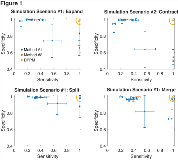Robust Dynamic Community Tracking With Applications to Human Brain Functional Networks During Seizures
Abstract number :
2.092
Submission category :
3. Neurophysiology / 3G. Computational Analysis & Modeling of EEG
Year :
2018
Submission ID :
501489
Source :
www.aesnet.org
Presentation date :
12/2/2018 4:04:48 PM
Published date :
Nov 5, 2018, 18:00 PM
Authors :
Mark Kramer, Boston University; Louis-Emmanuel Martinet, MGH/Harvard; Elizabeth Spencer, Boston University; Nathan Perkins, Boston University; Weston Viles, Colby College; Catherine J. Chu, Massachusetts General Hospital; Sydney Cash, MGH/Harvard; and Eri
Rationale: Clinical and experimental investigations suggest that brain regions interact in specific ways during a seizure. To assess these interactions, functional networks are inferred from multi-sensor recordings and the resulting functional networks examined. However, the complexity of these functional networks, and their rapid change during a seizure, makes understanding these network dynamics a unique challenge. More specifically, how functional networks evolve at seizure onset, and whether these networks organize into specific subsets of nodes that evolve in time - dynamic communities - remains poorly understood. Methods: We introduce a new methodology for dynamic community detection that addresses critical aspects unique to the analysis of dynamic functional networks inferred from noisy brain time series data. The proposed dynamic plex percolation method (DPPM) differs from existing dynamic community tracking procedures in two ways. First, we extract communities based on the explicit notion of time-evolving aggregations of plexes, rather than aggregations of cliques or through optimization of a cost criterion. Second, we account for edge noise - a factor in any set of functional networks inferred from time series data. These choices make DPPM robust to edge noise, and yields well-defined spatiotemporal communities that span forward and backwards in time. Results: We show in four simulation scenarios that DPPM outperforms two existing methods to accurately capture stereotypical dynamic community behaviors estimated from noisy data. Specifically, we show in simulation that two existing dynamic community approaches perform with high specificity (>0.95) but typically low sensitivity (<0.6), while DPPM performs with high sensitivity and specificity (>0.95); Figure 1. We then illustrate the ability of DPPM to track dynamic community organization in the context of a human seizure by analyzing invasive brain voltage recordings at seizure onset. We show evidence of a rapid, dynamic community expansion at seizure onset from an initial set of nodes, followed by a slow contraction of this community back to the initial node set, and that these results occur consistently across multiple seizures from the same patient (n=4); Figure 2. Conclusions: We conclude that DPPM can more accurately track dynamic communities inferred from noisy time series data than existing methods. We conjecture that application of this method will yield new insights into the functional network dynamics of seizure onset and potential targets for treatment of seizures. Funding: NIH NINDS Award R01NS095369

.tmb-.png?Culture=en&sfvrsn=893d1629_0)